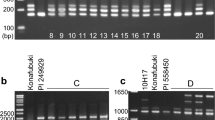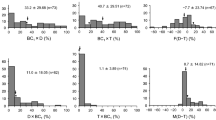Summary
Sterility-resistant cytoplasmic factors ofSolanum tuberosum spp.andigena (Juz. & Buk.) Hawkes and ofSolanum phureja (Juz. & Buk.) were combined with chromosomal genes ofS. tuberosum ssp.tuberosum. Eleven morphological characters of reciprocal F1 and BC1 progenies were monitored to evaluate rate of progression towards characteristics occurring in the recurrent ssp.tuberosum parent. Female and male fertilities of F1 and BC1 populations were also evaluated.
Cytoplasmic factors did not influence morphological parameters consistently, except those relating directly to fertility. Differences between reciprocal progeny depended more upon the genes of individual parents used in crosses than on cytoplasm source. No consistent reciprocal differences occurred in tuber characters and those differences which arose seem to reflect a maternal rather than a cytoplasmic influence. F1 and BC1 progenies containing the sterility-resistant cytoplasmic factors of ssp.andigena or ofS. phureja had higher fertility than their respective reciprocal progenies with cytoplasm of ssp.tuberosum.
Zusammenfassung
Es wurde ein Substitutions-Rückkreuzungsprogramm entwickelt, um die zytoplasmatischen Faktoren vonSolanum tuberosum L. ssp.tuberosum so zu ändern, dass eine Form entsteht, die keine Empfindlichkeit gegen dominante Gene für zytoplasmatische Sterilität aufweist. Sterilitäts-resistente zytoplasmatische Faktoren vonSolanum tuberosum ssp.andigena (Juz. & Buk.) Hawkes und vonS. phureja (Juz. & Buk.) wurden mit chromosomalen Genen vonS. tuberosum spp.tuberosum kombiniert (Tabelle 1). Elf morphologische Merkmale der reziproken F1 und BC1 Nachkommenschaften wurden ausgewählt, um die Steingerungsrate gegenüber Merkmalen, die in den wiederholt vorkommenden ssp.tuberosum Eltern auftreten, zu beurteilen und um das Ausmass zu bestimmen, in dem das Zytoplasma die Form der Pflanze beeinflusst. Weibliche und männliche Fertilität der F1 und BC1 Populationen wurden auch evaluiert. Die morphologischen Merkmale wurden durch die zytoplasmatischen Faktoren nicht einheitlich beeinflusst, mit Ausnahme der direkt mit der Fruchtbarkeit verbundenen Parameter (Tabellen 6 und 7). Die Unterschiede zwischen reziproken Nachkommenschaften hingen mehr von den Genen der bei der Kreuzung verwendeten individuellen Eltern ab, als von der zytoplasmatischen Herkunft (Tabellen 2–5). In den Knollenmerkmalen traten keine beständigen reziproken Unterschiede auf und die Unterschiede, die auftraten, schienen eher einen mütterlichen als einen zytoplasmatischen Einfluss aufzuweisen (Tabellen 2–5). F1 und BC1 Nachkommenschaften, die die Sterilitätsresistenten zytoplasmatischer Faktoren von ssp.andigena oderS. phureja enthielten, hatten eine höhere Fertilität als ihre reziproken Nachkommenschaften mit Zytoplasma von ssp.tuberosum (Tabellen 6 und 7). Die Verteilung der F1 und BC1 Werte für alle morphologischen Merkmale, die zur Kennzeichnung der Eltern verwendet worden waren, zeigte ihren polygenen Charakter. Eine Dominanz dertuberosum-Gene zeigte sich in der Blattstellung und bei den eingeschobenen Blättchen (Abb. 3), während die Merkmale der Blättchen eine Dominanz derandigena-Gene anzeigte (Abb. 1 und 2). Die Steigerungsrate in Richtung ssp.tuberosum war bei dem Blattstellungswinkel und der Zahl der eingeschobenen Blättchen (Abb. 3) schnell, denn in der F1-Generation wurdentuberosum-ähnliche Werte erreicht. Die Merkmale der Blättchen erreichten in der BC1-Generation Werte zwischen den Eltern (Abb. 1 und 2).
Résumé
Un programme de substitution par croisement en retour avait pour dessein de modifier les facteurs cytoplasmiques deSolanum tuberosum ssp.tuberosum dans le but d'obtenir un type qui ne présente pas de sensibilité au gène dominant de stérilité cytoplasmique.
Les facteurs de résistance cytoplasmique à la stérilité deSolanum tuberosum ssp.andigena (Juz. et Buk.) Hawkes et deSolanum phureja (Juz. et Buk.) ont été combinés avec les gènes deS. tuberosum ssp.tuberosum (tableau 1).
Onze caractères morphologiques de réciprocité chez les descendances F1 et BC1 ont été contrôlés pour évaluer le taux de régression vers les caractères parentaux deSolanum ssp. et pour déterminer l'influence du cytoplasme sur la forme des plantes.
La fertilité femelle et mâle des populations de F1 et BC1 s'avérait bonne.
Les facteurs cytoplasmiques n'ont pas beaucoup influé sur les paramètres morphologiques, à l'exception de ceux qui étaient en relation directe avec la fertilité (tableaux 6 et 7).
Les différences entre les descendances réciproques dépendaient plus des gènes de chacun des parents utilisés dans les croisements que des origines cytoplasmiques (tableaux 2–5). Aucune différence réciproque importante n'a été observée pour les caractères du tubercule et celles qui apparaissent semblaient plus dépendre de l'influence maternelle que du cytoplasme (tableaux 2–5).
Les descendances F1 et BC1 renfermant les facteurs de résistance cytoplasmique à la stérilité provenant de ssp.andigena etS. phureja avaient un taux de fertilité plus grand que les descendances réciproques ayant du cytoplasme de ssp.tuberosum (tableaux 6–7). La distribution des F1 et BC1 au niveau de tous les caractères morphologiques étudiés pour représenter les parents, traduisait leur nature polygénique. L'angle des feuilles et les folioles intermédiaires montraient une dominance des gènestuberosum (fig. 3) tandis que les caractères présentés par les folioles étaient en rapport avec la dominance des gènesandigena (fig. 1 et 2). Le taux de régression vers ssp.tuberosum était rapide pour l'angle des feuilles et le nombre des folioles intermédiaires (fig. 3) chez les F1, comparativement aux valeurs detuberosum. Les caractères habituels des folioles étaient donnés par la valeur moyenne des parents pour les BC1 (fig. 1 et 2).
Similar content being viewed by others
References
Abdalla, M. M. F. & M. S. Ramanna, 1971. Male sterility inSolanum polytrichon × S. phureja hybrid caused by plasmon-genic interaction and its significance.Euphytica 20: 482–489.
Clark, C. F., 1927. Types of sterility in wild and cultivated potatoes.Mem. hort. Soc., N.Y. 3: 289–294.
Correll, D. S., 1962. The potato and its wild relatives. Texas Research Foundation. Renner, Texas. 525 pp.
Cubillos, A. G. & R. J. Plaisted, 1976. Heterosis for yield in hybrids betweenS. tuberosum ssp.tuberosum andtuberosum ssp.andigena.Am. Potato J. 53: 143–150.
Glendinning, F., 1969. The performance of progenies obtained by crossing Groups Andigena and Tuberosum ofSolanum tuberosum.Eur. Potato J. 12: 13–19.
Grun, P., 1961. Early stages in the formation of internal barriers to gene exchange between diploid species ofSolanum.Am. J. Bot. 48: 79–89.
Grun, P., 1974. Cytoplasmic sterilities that separate the Group Tuberosum cultivated potato from its putative tetraploid ancestor.Evolution 27: 633–643.
Grun, P., 1979. Evolution of the cultivated potato: a cytoplasmic analysis. In: J. G. Hawkes et al. (Eds.), The biology and taxonomy of the Solanaceae. Linnean Society Symposium No 7. Academic Press. (London), 655–665.
Grun, P. & J. Staub, 1981. Evolution of tetraploid cultigens from the view of cytoplasmic inheritance. Proc. 3rd Planning Conference on Exploration, Taxonomy and Maintenance of Potato Germ Plasm, pp. 141–152. International Potato Center, Lima, Peru.
Grun, P., C. Ochoa & D. Capage, 1977. Evolution of cytoplasmic factors in tetraploid cultivated potatoes.Am. J. Bot. 64: 412–420.
Hawkes, J. A., 1956. Taxonomic studies on the tuber-bearingSolanums. I.Solanum tuberosum and the tetraploid species complex.Proc. Linnean Soc. Lond. 166: 97–144.
Hoopes, R. W., R. L. Plaisted & A. G. Cubillos, 1980. Yield and fertility of reciprocal-crosstuberosum-andigena hybrids.Am. Potato J. 57: 275–284.
Koopmans, A., 1951. Cytogenetic studies onSolanum tuberosum L. and some of its relatives.Genetica 25: 193–337.
Koopmans, A. 1952. Changes in sex in the flowers of the hybridSolanum rybinii × S. chacoense.Genetica 26: 359–380.
Koopmans, A., 1955. Changes in sex in the flowers of the hybridSolanum rybinii × S. chacoense. III. Data about the reciprocal crossSolanum chacoense × S. rybinii.Genetica 27: 465–471.
Mullin, R. & F. I. Lauer, 1966. Breeding behavior of F1, and inbred potato clones.Proc. Am. Soc. hort. Sci. 89: 449–455.
Paxman, G. J., 1966. Heterosis inandigena hybrids.Rep. John Innes Inst. 1965: 51–53.
Rothacker, D., 1962. Populationsanalytische Untersuchungen über die Leistung verschiedener Kreuzungskombinationen zwischen ssp.andigena und ssp.tuberosum vonS. tuberosum.Eur. Potato J. 5: 1–13.
Salaman, R. N. & J. W. Lesley, 1922. Genetic studies in potatoes: Sterility.J. agric. Sci., Camb. 12: 31–39.
Salaman, R. N., 1926. Potato Varieties, Cambridge University Press, London.
Sanford, J. C. & R. E. Hanneman, Jr., 1979. Reciprocal differences in the photoperiod reaction of hybrid populations ofSolanum tuberosum.Am. Potato J. 56: 531–540.
Shapiro, S. S. & W. B. Wilk, 1965. An analysis of variance test for normality (complete samples).Biometrika 52: 591–611.
Simmonds, N. W., 1964. Studies of the tetraploid potatoes II. Factors in the evolution of the Tuberosum Group.J. Linnean Soc. (Bot.) 59 (376): 43–56.
Tarn, T. R. & G. C. C. Tai, 1973. Heterosis in F2 hybrids between Group Andigena and Group Tuberosum potatoes.Am. Potato J. 50: 337 (abstr.).
Tarn, T. R. & G. C. C. Tai, 1977. Heterosis and variation of yield components in F1 hybrids between Group Tuberosum and Group Andigena potatoes.Crop Sci. 17: 517–521.
Author information
Authors and Affiliations
Additional information
Pennsylvania Agricultural Experiment Station Journal Series No 6212.
Rights and permissions
About this article
Cite this article
Staub, J.E., Grun, P. & Amoah, V. Cytoplasmic evaluations during substitution backcrossing inSolanum . Potato Res 25, 299–319 (1982). https://doi.org/10.1007/BF02357288
Accepted:
Issue Date:
DOI: https://doi.org/10.1007/BF02357288




